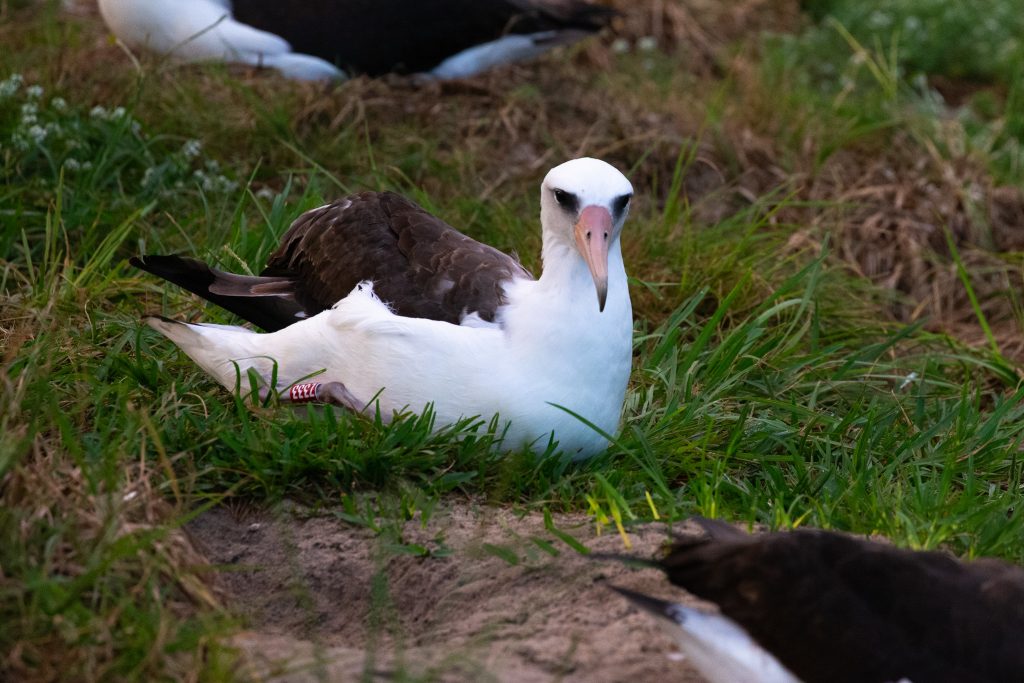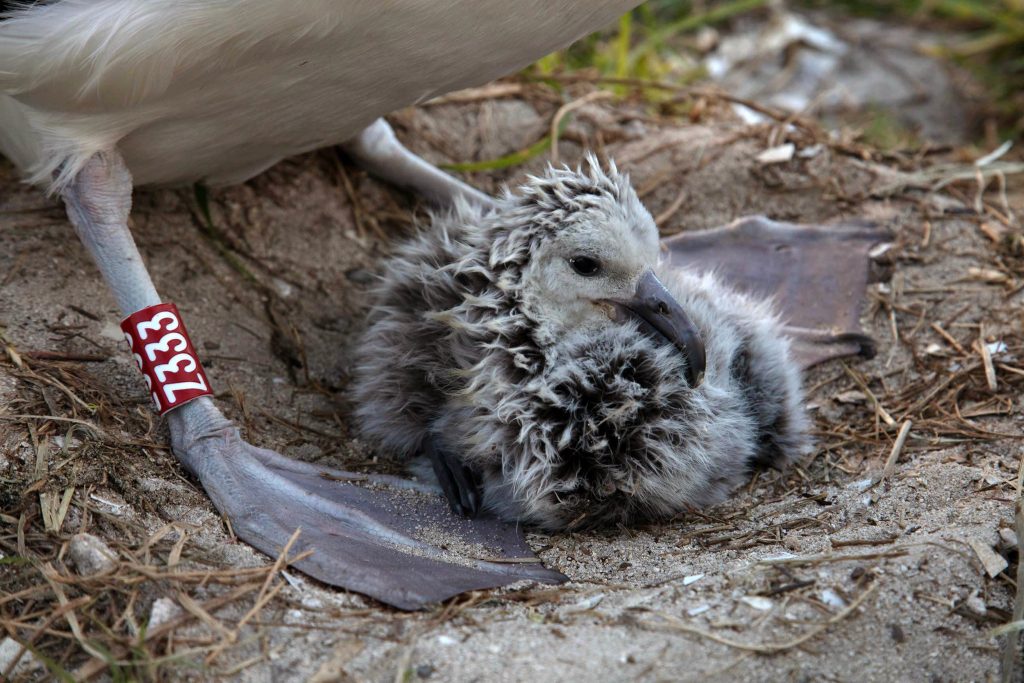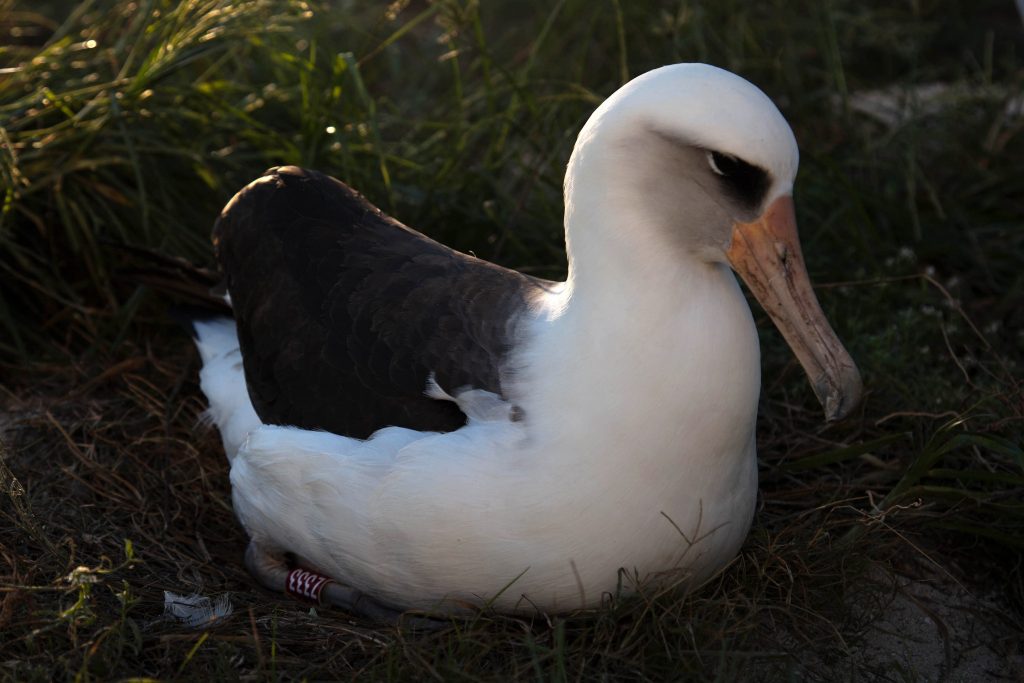World’s Oldest Banded Wild Bird Returns to Midway Atoll in Time for her 70th Birthday
Entering her eighth known decade at Midway Atoll, Wisdom, a mōlī (Laysan albatross) and the oldest known banded wild bird has returned to her winter home at Midway Atoll National Wildlife Refuge and Battle of Midway National Memorial.
This year, the first observation of Wisdom at her nest site took place on Nov. 26, just a day sooner than her arrival date last year.
Each year millions of albatrosses return to Midway Atoll in Papahānaumokuākea Marine National Monument to nest and raise their young.
Culturally, albatross species are kinolau (body form) of the Hawaiian deity Lono. The birds’ return to land for mating coincides with the beginning of the makahiki season, occurring between October and November, and the birds are an important aspect to some practitioners’ ceremonies and practices during that time.

Wisdom is Midway Atoll’s oldest known current resident, witnessing for seven decades the major events and transformations that have taken place on the atoll, and thriving while globally significant events were occurring around the world.
She may have seen the first “Willy Victor” plane flights from Midway Atoll in the late 50’s, and witnessed Midway Atoll’s change from an active naval airfield to a refuge for wildlife. She’s lived through globally significant events, such as the first walk on the moon, the end of the Cold War and the designation of Papahānaumokuākea as a Marine National Monument.
Wisdom and her mate, Akeakamai, like most pairs of albatrosses, return nearly every year to the same nest site – a behavior known as nest site fidelity. Albatrosses lay one egg each nesting season and often take a year off from nesting. Most Laysan albatrosses return to Midway Atoll’s during November when mating begins; and most eggs are laid by early December. After about 65 days of incubation, eggs hatch in late January or early February.
“There have been no observations of Akeakamai this year and no evidence of a nest cup; so it is unlikely that they will nest this year,” said Jon Plissner, Wildlife Biologist at Midway Atoll. “We will continue to monitor the area through the month of December, as a few new nest starts of Laysan albatross can occur in December.”
The last sighting of Wisdom around her nest cup was Dec. 5. It is most likely that she has returned to sea. Raising the next generation of albatross is no easy job and requires two parents. They take turns incubating the egg or caring for the chick while the other forages for food at sea. Albatross parents will spend time on Midway Atoll incubating and raising their chick over a 7-8 month period.

It is normal for albatrosses take a year off from parenting between chicks. Wisdom and her mate have met on Midway Atoll to lay and hatch an egg almost every year since 2006. It is estimated that Wisdom has laid between 30-36 eggs in her lifetime. In 2018, her chick that fledged in 2001 was observed just a few feet away from her current nest, marking the first time a returning chick of hers has been documented. The chick returned to the same area each year since then but this December was found 200 yards away on a nest of its own.
Starting around age five, juvenile albatrosses begin the process of finding a mate. During nesting season, they are all over Midway Atoll practicing elaborate courtship dances containing dozens of ritualized movements. These young birds are looking for that special bird to dip, bow, and preen with, and once a pair bond forms they stay bonded for life.
Biologists first identified and banded Wisdom in 1956 after she had laid an egg, perhaps her first egg. Female Laysan albatrosses aren’t known to breed before age 5, indicating that Wisdom would have hatched as late as 1951, which would make her at least 70 years old at this point of her life-journey. Dec. 10, 2021 marked the 65th Anniversary of her discovery when she was first banded.

“Wisdom continues to help us better understand how long these birds live and how often they breed. It is incredible to know that Wisdom is surrounded by generations of her family at Midway Atoll” said Pam Repp, Refuge Manager for Midway Atoll National Wildlife Refuge and Battle of Midway National Memorial. “It is thanks to bird banding that we know Wisdom is at least 70 years old and where her family members spend the winter at Midway Atoll”.
Throughout the Monument, scientific research and monitoring plays an essential role in managing wildlife, including seabirds. Surveys and banding projects conducted in the Monument and throughout the world help scientists better understand the life cycles and migration patterns of birds. Biologists first identified and banded Wisdom in 1956, but the very first albatross was banded on Midway Atoll in 1936. To date over 275,000 albatrosses have been banded at the Refuge and Memorial. By pairing modern data analysis with detailed current and historical records, biologists can make more informed management decisions that ensure seabirds have the habitat and resources they need in the future.
Nearly 70% of the world’s mōlī and almost 40% of kaʻupu (black-footed albatross), as well as endangered makalena (short-tailed albatross) all rely on Midway Atoll. In addition to albatrosses, over 20 different bird species live on Midway Atoll. In total, over three million individual birds call the Refuge and Memorial home.
Biologists and volunteers are working to restore the habitat seabirds need at Midway Atoll and remove threats like invasive predators – because protecting the future for seabirds mean protecting the places they call home.
Located on the far northern end of the Hawaiian archipelago, Midway Atoll Refuge and Memorial is managed by the US Fish and Wildlife Service and lies within the Papahānaumokuākea Marine National Monument. It is one the oldest atoll formations in the world, provides nesting habitat for millions of seabirds, and is a touchstone for one of the most significant naval battles of World War II, and in history, the Battle of Midway.
Courtesy: US Fish and Wildlife Service, Pacific Islands







